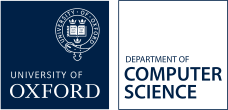Introduction to Groups, Rings and Fields: 2008-2009
Terms | Hilary Term 2009 | Trinity Term 2009 |
Overview
Abstract algebra evolved in the twentieth century out of nineteenth century discoveries in algebra, number theory and geometry. It is a highly developed example of the power of generalisation and axiomatisation in mathematics. The first objective is to develop some concepts of set theory as a useful language for abstract mathematics. Next we aim to introduce the student to some of the basic techniques of algebra. Thirdly, we aim to introduce group theory through axioms and examples both because groups are typical and famous examples of algebraic structures, and because of their use in the measurement of symmetry. Finally we begin the study of fields and rings which are important in the study of polynomials and their zeros.Learning outcomes
Students will have developed an abstract approach to reasoning about number systems, their arithmetic structures and properties. They will be familiar with the axioms of a group, ring, and field together with examples. They will have a detailed knowledge of the ring of integers and the ring of polynomials and the Euclidean Algorithm in each case. They will have developed an appreciation of the isomorphism theorem for groups and rings.Synopsis
Review of algebraic structures encountered in the course so far:  ,
,  ,
,  ;
;  and
and  .
.
Concept of a binary operation. Axioms for a group. Examples from above, including invertible  matrices under multiplication; note that a vector space is an Abelian group under
matrices under multiplication; note that a vector space is an Abelian group under  .
.
Axioms for a ring (not assumed commutative with identity). Optional additions:  commutative;
commutative;  identity for multiplication. Examples. Definition of a field and an integral domain, with preliminary examples. Fact that a field is an ID. [2 lectures]
identity for multiplication. Examples. Definition of a field and an integral domain, with preliminary examples. Fact that a field is an ID. [2 lectures]
The integers as an example of an integral domain which is not a field. Division algorithm and Euclidean algorithm. Polynomials with real or complex coefficients; ring structure, degree of a polynomial; Division algorithm, Euclid's algorithm; the Remainder Theorem. Statement of Fundamental Theorem of Arithmetic. [2 lectures]
lectures]
Relations, equivalence relations, partitions; examples, including integers mod  .
.
Review of permutations of a finite set:  as a group. Decomposition of a permutation into a product of disjoint cycles. [2 lectures]
as a group. Decomposition of a permutation into a product of disjoint cycles. [2 lectures]
Groups in general, with additional (straightforward) examples. Subgroups, with examples. Products of groups. [1 lectures]
lectures]
TT (8 Lectures)
Brief review of HT course.
Cyclic groups; order of an element; fact that a subgroup of a cyclic group is cyclic. Cosets and Lagrange's Theorem; simple examples.
Homomorphisms of groups with motivating examples. Kernels, normal subgroups, The 1st Isomorphism Theorem. More on  : conjugacy in
: conjugacy in  and relationship to normality. [6 lectures]
and relationship to normality. [6 lectures]
Ring homomorphisms and their kernels; examples. Ideals in commutative rings, 1st Isomorphism Theorem for commutative rings; the example of integers mod  . [2 lectures]
. [2 lectures]
Remark: The number of lectures is an indicative guide.
Reading list
- R. B. J. T. Allenby, Rings, Fields and Groups (Edward Arnold, Second Edition, 1999). [Out of print, but available in many libraries also via Amazon]
- I. N. Herstein, An Introduction to Abstract Algebra (Wiley, Third edition, 1996), ISBN - 978-0-471-36879-3.
Alternative reading
- N. L. Biggs, Discrete Mathematics (OUP, revised edition).
- Peter J. Cameron, Introduction to Algebra (OUP 1998), 1.1, 1.2, 1.3, 1.4, 3.1, 3.2, 3.3, 3.4.
- John B. Fraleigh, A First Course in Abstract Algebra (Pearson, Seventh edition, 2002).
- W. Keith Nicholson, Introduction to Abstract Algebra (John Wiley, Second edition, 1999), 1.2, 1.3, 1.4, 2.1, 2.2, 2.3, 2.4, 2.5, 2.6, 2.7, 2.8, 2.9, 2.10.
- Joseph J. Rotman, A First Course in Abstract Algebra (Prentice-Hall, Second edition, 2000), 1.1, 1.2, 1.3, 2.1, 2.2, 2.3, 2.4, 2.5, 2.6, 3.3, 3.5.
- G. C. Smith, Introductory Mathematics: Algebra and Analysis (Springer Undergraduate Mathematics Series, 1998), Chapters 1, 2, 5.
Taking our courses
This form is not to be used by students studying for a degree in the Department of Computer Science, or for Visiting Students who are registered for Computer Science courses
Other matriculated University of Oxford students who are interested in taking this, or other, courses in the Department of Computer Science, must complete this online form by 17.00 on Friday of 0th week of term in which the course is taught. Late requests, and requests sent by email, will not be considered. All requests must be approved by the relevant Computer Science departmental committee and can only be submitted using this form.
